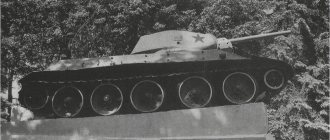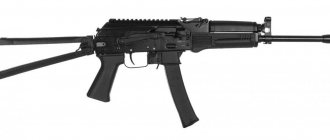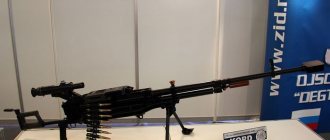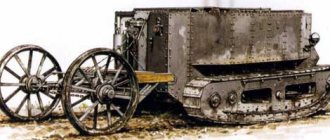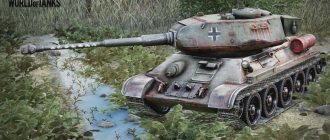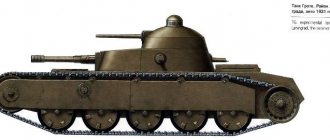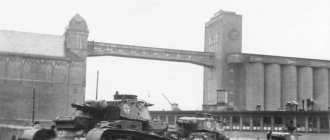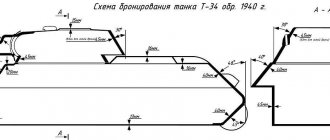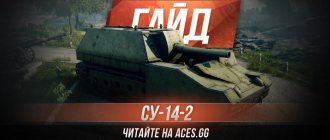Heavy tank KV-9
The first months of the Great Patriotic War clearly demonstrated the success of the concept of a heavy tank with powerful weapons. KV-1 tanks during this period posed a serious threat to the majority of German armored vehicles and at the same time were too tough for the bulk of German anti-tank weapons. However, for some tasks the armament of the KV-1 tanks in the form of a 76-mm cannon was insufficient. The existing KV-2 tanks with a 152 mm gun were produced in clearly insufficient quantities. Ultimately, seven times fewer KV-2 tanks will be assembled than KV-1. It is unlikely that more than three hundred tanks with a powerful gun could change the situation on the fronts. The low rate of production of the KV-2 did not cover the needs of the Red Army in the so-called. assault tanks. Therefore, in November 1941, the design bureau of the Chelyabinsk Tractor Plant was tasked with developing a new multi-purpose tank capable of fighting both armored vehicles and enemy fortifications.
The original designs of the KV-1 and KV-2 were taken as the basis for the Object 229 tank. The chassis with a 600-horsepower diesel engine, torsion bar suspension and sufficient driving characteristics for a heavy tank was taken from the second version of the KV. A slightly modified turret of the KV-1 tank was installed on it. The changes primarily concerned the dimensions of the window for installing the gun. In addition, the location of some instruments inside the tower has been changed. But these changes are also a consequence of the installation of a new weapon. In accordance with the assault mission of the Object 229, the armor protection of the hull was changed. Thus, the thickness of the frontal plate was increased to a huge 135 millimeters for those times. The forehead of the tower became even thicker. On the new assault tank this parameter was 210 millimeters.
The U-11 cannon was proposed as the main weapon of the Object 229 at the very beginning of its design. This 122-mm tank howitzer was created in July 1941 at the design bureau of the Ural Machine-Building Plant under the leadership of engineers V. Sidorenko and N. Usenko. The goal of the design work was to create a promising type of weapon, with the help of which the combat qualities of existing KV-1 tanks could be significantly improved. In this case, the breech of the gun had to fit into the tank turret. The size requirements made the work of the engineers somewhat more difficult, but by September they managed to eliminate all the difficulties and snags. At the same time, the military-political leadership of the country approved the continuation of work on the U-11 and ordered the construction of an experimental batch of these guns. The first sample was collected in December.
Until April of the following year, ten new howitzers were made at the pilot production of plant No. 9, two of which were sent to other plants for use in testing new tanks. The copy delivered to ChTZ was installed in the modified KV-1 turret and the resulting “Object 229” was sent for testing. The separate-loading tank gun was sufficiently developed even before the production of the test batch, so the testers did not have any special problems. The U-11 howitzer was developed on the basis of the M-30 gun and had similar ballistics. Therefore, 122 mm ammunition created for the M-30 was used to fire the U-11. The stowage of the Object 229 tank could accommodate 48 shells and cartridges. Loading was done manually by an individual crew member. The gun suspension system made it possible to aim it in a circle in the horizontal plane by rotating the turret and within the range from -4° to +19.5° in the vertical plane. The gun was equipped with a TMFD telescopic sight, which allowed firing at ranges of up to 1300 meters.
Tests of the new tank that began in the spring of 1942 showed the correctness of the chosen path. Powerful weapons allowed “Object 229” to effectively fight all types of armored vehicles the Germans had, and in addition, the U-11 gun was convenient for destroying long-term firing points, dugouts and other fortifications. However, during testing, problems with recoil devices repeatedly arose. This unit of the U-11 howitzer was actually designed from scratch and had significantly smaller dimensions compared to the recoil devices of other guns. Testers and engineers of the Chelyabinsk Tractor Plant, having joined forces with the designers of Uralmash, nevertheless managed to cope with the “childhood diseases” of the howitzer and the tests of the tank were successfully completed. The commission that monitored the tests of Object 229 recognized the project as a success and recommended it for adoption. A new index was even invented - in accordance with the established tradition of naming heavy tanks, “Object 229” was renamed KV-9.
According to the initial plans, adopted immediately after the recommendation was issued, the Chelyabinsk Tractor Plant was to produce a pre-production batch of ten KV-9 tanks. It was understood that all experienced U-11 howitzers would be used. However, for a number of different reasons, only one pre-production tank was assembled. Firstly, Plant No. 9 could not switch to the production of a new weapon quickly and without sacrificing other products, and secondly, the command’s views on the role of heavy tanks began to change. Finally, the creation of the SU-122 self-propelled gun was in full swing and the launch of production of a tank with a similar weapon was considered unprofitable. The Object 229 project was closed, and the efforts of the ChTZ design bureau were redirected to other, more promising areas.
Based on materials from the sites: https://redtanks.bos.ru/ https://battlefield.ru/ https://armor.kiev.ua/
New in blogs
The years 1937-1938 became a time of breakthrough for the armament of the Red Army, after 8 years of downtime and inaction.
In June 1940, the NKO, based on the experience of using tanks in the Polish campaign and the Soviet-Finnish war, considered the issue of forming tank divisions.
On May 27, a memo was submitted to the Politburo and the Council of People's Commissars, which described the structure of the tank division in the amount of 386 tanks, 108 armored vehicles, 42 guns and 72 mortars.
At the same time, the question was raised about the formation of tank corps consisting of two tank and one motorized divisions, as well as a motorcycle regiment and other units. According to the staff, it was supposed to have 36,080 people. and 1031 tanks.
In total, according to NGOs, 6 tank corps should have been formed and deployed two in BOVO and KOBO, as well as one in OdVO and ZabVO. However, this proposal was not approved and was returned for revision.
On June 2, 1940, the People's Commissar of Defense and the Chief of the General Staff presented a plan for the creation of tank corps .
It was proposed to form 8 tank corps, 18 tank and 8 motorized divisions, which would be located one each in the Moscow Military District, Leningrad Military District, Odvo and ZabVO, 2 each in BOVO and KOBO, and 1 tank division in ZakVO and CABO.
On July 6, 1940, the Council of People's Commissars, by resolution No. 1193-464ss, approved the proposed organization, deployment and staffing levels of tank forces.
But the NPO admitted that this led to a temporary reduction in part of the tank brigades of the rifle corps. In order not to leave the infantry without escort tanks, it was necessary to have about 6,000 more tanks.
NEW GUNS FOR TANKS
At the end of 1937, the Main Artillery Directorate of the Red Army, on the basis of a letter of representation from the head of the ABTU D. Pavlov, decided to develop 76-mm guns for heavy tanks with the ballistics of a divisional gun mod. 1902
At the beginning of 1938, the design bureau of the Kirov plant received the task of designing such an artillery system for arming T-28 tanks.
The design of the L-10 cannon was taken as a basis, but the barrel length was increased and the breech was strengthened to use shots from a divisional gun (the L-10 could use shots intended only for the “regimental” gun).
Upon completion of the tests, the L-11 was recommended for adoption with the condition that the noted deficiencies were eliminated, and in the same year the production of an installation series of guns began for military testing.
In April, the L-11 cannon was adopted for service with the T-28 and BT-7A tanks during their planned modernization, as well as for equipping promising heavy and medium tanks.
But even before the start of the Soviet-Finnish war, the Main Art Directorate of the Red Army was rocked by a scandal. As L. Gorlitsky recalled:
“What we all feared has happened!”
At that time, he was deputy chief designer of the LKZ S. Makhanov for artillery weapons and took part in the development of the L-11 tank gun.
During the summer exercises of 1939, it suddenly became clear that many tanks armed with the 76.2 mm L-10 cannon could not be considered combat-ready.
The fact is that the design of this gun had one unpleasant feature.
The volume of its recoil brake was connected through a small hole with atmospheric air, and if during operation it was necessary to alternately fire quickly at different positions of the barrel (up - down), the hole was blocked and the liquid boiled when fired, bursting the brake cylinder.
In a tank moving over rough terrain, such “challenge” with shooting was not uncommon (shooting exercises on the move, and from short stops), and therefore not a single tank armed with the L-10 gun could be considered insured against such a nuisance.
The design of the new L-11 gun was similar to the L-10, and therefore it was set aside until the noted shortcomings were eliminated.
Tasks for the design of a new tank gun with a caliber of 76.2 mm with a barrel length of 30 calibers were received by OKB-92 of the Gorky Artillery Plant No. 92 named after I. Stalin under the leadership of V. Grabin and the design bureau group of the Motovilikha plant under the leadership of Sidorenko.
V. Grabin used the swinging part of his divisional gun model 1936 (F-22) in the project and completed it in a very short time.
In addition, since the gun used a well-developed design of a mass-produced divisional gun, its performance was beyond doubt, and the parts mastered in mass production made its cost very low.
All these factors led to the fact that already in the fall of 1939 the new gun, designated F-32, entered parallel tests with a product from the Kirov plant (L-11). According to the assignment, the guns were tested in the turrets of the BT-7A and T-28 tanks and showed similar results.
Tank BT 7A, armed with a 76.2 mm F-32 cannon, undergoing testing. 1940
The BT-7A tank, armed with a 76.2 mm L-11 cannon, is being tested. 1940
Since the L-11 recoil brake, in order to correct the shortcomings identified in the L-10, was supplemented with a reserve hole with a valve for communication with air when firing at a declination angle, no destruction of the recoil brake was found during joint tests with the F-32. But, despite some simplification of the design, the complexity and cost of the L-11 were high!
The production of L-11 mechanisms required a wide range of alloy steels and non-ferrous metals; the production of the lion's share of components required high-precision and clean milling work.
At the same time, the components and mechanisms of the F-32 (which itself had fewer parts) could be made from cheap types of structural steel.
Tolerances for the manufacture of parts were more lenient compared to the L-11, which quite logically led to the recommendation for the adoption of the BT-7A, A-32, T-28, and KV tanks by the F-32 instead of the L-11.
In January 1940, the F-32 cannon was adopted by the armored forces of the Red Army with the start of serial production at LKZ in the 2nd quarter.
AFTER THE FINNISH….
After the end of the Soviet-Finnish war in April 1940, the military leadership of the USSR, based on the acquired combat experience, began yet another reform of the artillery, tank and aviation weapons system of the Red Army.
To the greatest extent, the coming changes affected the artillery armament of tanks, which had previously been considered more than sufficient.
On June 13, 1940, a memorandum was sent to the Central Committee of the All-Union Communist Party of Bolsheviks and the Council of People's Commissars of the USSR about
“...insufficient armament power of the new KV and T-34 tanks, as well as other types of promising tanks under design”
On June 27, a special meeting of the Council of People's Commissars and the Central Committee of the All-Union Communist Party of Bolsheviks was scheduled to discuss this issue.
At this meeting, 45-mm tank guns were recognized as unpromising, and heavyweights were actively “promoted” for arming heavy tanks - 85-107 mm caliber guns, as well as 122-152 mm howitzers.
By the end of the summer of 1940 (apparently after the GAU meeting on August 17-19), the existing classification of tank guns by caliber in the Red Army was revised. If previously the 45 mm caliber was considered “medium”, now it was classified as “small”.
The classification of tank guns by caliber, adopted on October 1, 1940, was as follows:
“1.) small-caliber tank guns - up to 45 mm (considered a temporary measure until the development of special tank guns of 55-60 mm caliber);
2.) medium caliber tank guns - from 76 mm to 95 mm;
3.) tank guns of large calibers - more than 95 mm (since 1941, more than 107 mm)."
But if everything was more or less clear with small-caliber and medium-caliber guns, then large-caliber guns had to be created anew.
NEW WEAPONS
Back in March 1938, the Main Artillery Directorate issued preliminary technical specifications for a 95-mm divisional and tank gun and a high-power 76-mm tank gun.
Soon V. Grabin began design work on a tank gun “with the ballistics of an anti-aircraft gun mod. 1938" (the anti-aircraft gun model 1938 had the ballistics of the 3K gun model 1931). The project was carried out under the designation F-27, but the tank was not allocated for it.
The project was soon stopped, as at the beginning of 1939 a decision was made to stop production of 76-mm anti-aircraft guns and switch to an 85-mm gun.
V. Grabin followed almost the same path and in the spring of 1939 he proposed to the GAU the 85-mm F-30 cannon, which differed from the F-27 only in the 85-mm barrel pipe and a slightly elongated recoil brake.
A sample of the gun was installed in the turret of the T-28 tank, in which it was tested by cart. But firing tests were not carried out, since, firstly, there was not the required number of shots and, secondly, the recoil reaction of the gun to the shoulder strap was expected to be somewhat higher than what was allowed by the design.
The gun passed tests on artificial recoil and intensive loading and unloading at various elevation angles in place and on the move in September 1939.
And next year it was recommended to hand over the gun “ for field testing in a heavy tank from the Kirov plant.”
85-mm F-30 cannon in the turret of a T-28 tank during cart testing. Collage from the GAU report, 1939
CANNON ON A NEW TANK
However, it was not possible to install the specified gun in the turret of the KV-1 tank (the large dimensions of the breech had an effect, since according to the instructions it was not allowed to extend the recoil brake beyond the turret).
In August 1940, updated specifications were given for the 85-mm F-30 cannon in the turret of the KV tank, but only at the beginning of 1941 it was mounted in the turret of the new T-220 tank (KV-220), which had an increased range of service.
The installation turned out to be unbalanced, and the tank went to plant No. 92 to refine the artillery system. Only in March 1941 did the gun successfully pass the first stage of testing and was recommended for adoption.
However, by that time, more powerful 107-mm artillery systems were already being considered for arming heavy tanks, and the F-30 gun did not receive further development.
In January 1940, using the NII-13 ballistic solution, a 95 mm caliber round and the design of the 85 mm F-30 gun, OKB-92 designed and manufactured a prototype of the F-39 tank gun.
A 95-mm F-39 tank gun in the turret of a T-28 tank being tested with a cart. 1940
Work on the creation of the most popular domestic tank gun during the war, the F-34, began at OKB No. 92 in the summer of 1940.
The preliminary design was carried out on the basis of an order from the NKSM (agreement dated June 2, 1940), concerned with the creation of a “partial modernization” T-34 tank (A-41 tank).
According to the requirements of the NKSM, put forward on the basis of the decision of the CO under the Council of People's Commissars and the Central Committee of the All-Union Communist Party of Bolsheviks on June 13, 1940, to arm the new medium tank, a 76-mm gun with the ballistics of the F-22 divisional gun was required.
By order of the NKV No. 164 of June 14, 1940, Plant No. 92 was ordered to begin testing a new gun from a field machine on September 1, 1940.
To save time, OKB No. 92 used an almost completed project of a 76-mm tank gun with the ballistics of an anti-aircraft gun mod. 1931/38 – F-27. Only those changes were made to the project that were required to balance the shorter barrel, as well as simplify the manufacturing technology.
From September 15 to 25, the F-34 gun underwent a firing program from a field machine (from the F-22USV gun). By October 1, the experimental gun was installed in the turret of the BT-7A gun and entered factory testing by running in and firing.
The tests ended on November 20, and since no serious flaws were found in the design of the gun, already on November 21 the gun was recommended for adoption and appeared before the NPO acceptance committee.
The design of the 107-mm (more precisely, 106.7-mm) tank gun was started by OKB No. 92 in 1940 on its own initiative, but with the verbal approval of D. Pavlov.
The gun, designated F-42, was designed based on the design of a 95-mm tank gun mod. 1939 F-39 under the ballistics of the heavy divisional gun M-60 (initial speed 730 m/s). The gun was intended to arm heavy tanks.
By the beginning of 1941, by decision of the People's Commissariat of Defense of November 1940, a prototype was manufactured, which passed factory and field tests on a field carriage.
But the weapon was not accepted for service.
CONCLUSION
With big problems, but the shortage of good guns was resolved in the Red Army.
The main producers of guns were GBK and Petrov Design Bureau, which even surpassed the Grabinsk enterprise
